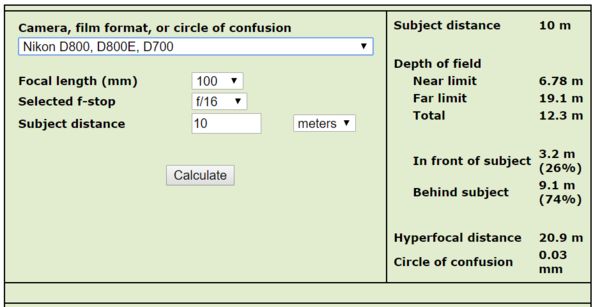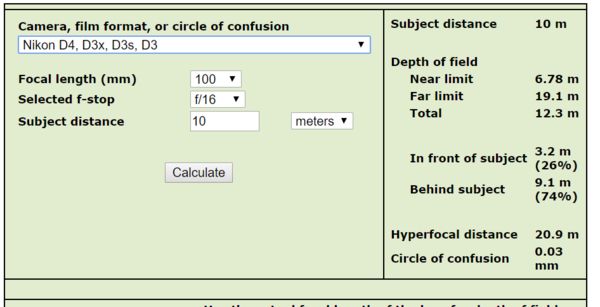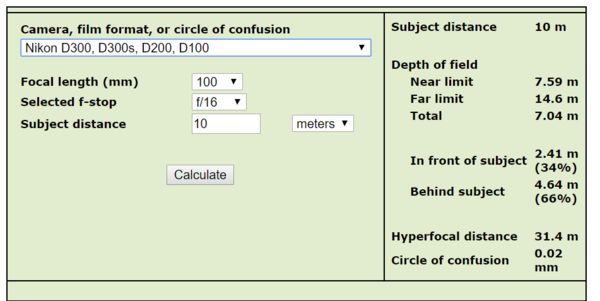Check out Film Photography section of our forum.
FX lens on a DX camera...
Jan 24, 2018 18:09:02 #
Rongnongno wrote:
.../... Now compare two lenses DX and FX respectively set as DX lens - DX body and FX lens - FX lens.
Here you will see a difference of perspective as well as a different of FAS for the same aperture. Why? Because the lenses angle of view is different depending on the camera format..../...
Here you will see a difference of perspective as well as a different of FAS for the same aperture. Why? Because the lenses angle of view is different depending on the camera format..../...
Jan 24, 2018 18:16:15 #
amfoto1 wrote:
In the most basic terms, it really doesn't matter ... (show quote)
You are not understanding CoC, sensor size and DoF - if everything is the same except for the sensor size, why does every DoF calculator show that the larger sensor has greater depth of field. It's not complex, it's simple algebra. The smaller CoC of the smaller sensor requires a higher magnification when printing, which makes the image "softer" near the focus plane - the result is shallower depth of field. it even makes sense intuitively. But since most of us judge an image's sharpness on a screen the benefit of looking at this phenomenon in a print is entirely lost.
But as well as I think I understand this - if you have a favorite DoF calculator that shows otherwise, please share it.
Jan 24, 2018 18:16:39 #
Rongnongno wrote:
I stand by it.
Ron, you are obviously a smart guy - you’re just considering this in an incorrect manner. Take a pause, rethink this in light of mine and Gene’s examples, and decide if you need to view it from a different perspective (no pun intended).
Chris
Check out Software and Computer Support for Photographers section of our forum.
Jan 24, 2018 18:19:28 #
Rongnongno wrote:
The only change resides in the angle of view.
That folks are confused is due to misleading marketing, nothing else.
Same thing as folks fooling themselves into thinking that cropping is a magnification.
That folks are confused is due to misleading marketing, nothing else.
Same thing as folks fooling themselves into thinking that cropping is a magnification.
You are 100% correct - the crop factor does not increase magnification. It does the same thing cropping the image in post processing does. The only advantage is that when you use a crop camera, you usually have more megapixels and slightly higher fine detail capture, usually at the expense of greater noise.
Jan 24, 2018 18:19:39 #
I give up out of frustration, not because I am wrong.
You CANNOT change the physical settings of a lens by using a cropped circle of confusion.
If you want to change the focal length of a lens you must use a lens adapter. Cropping does NOTHING.
Changing the internal angle of view by using a smaller sensor is not changing the lens angle of view.
If you cannot understand this, sorry folks, not my problem.
You CANNOT change the physical settings of a lens by using a cropped circle of confusion.
If you want to change the focal length of a lens you must use a lens adapter. Cropping does NOTHING.
Changing the internal angle of view by using a smaller sensor is not changing the lens angle of view.
If you cannot understand this, sorry folks, not my problem.
Jan 24, 2018 18:24:29 #
Rongnongno wrote:
Sorry Gene but nowhere in your post to I see the lens selection as being the same (FX on a DX body).
Same lens (FX lens on FX body and DX lens on DX body) with the same parameter will produce different results, as you illustrated.
Same lens (FX lens on FX body and DX lens on DX body) with the same parameter will produce different results, as you illustrated.
The focal length is the same. 50mm. I have yet to see a DoF chart or calculator that takes into consideration the lens format. What exactly do you think would be different about an FX lens and a DX lens that would lead to your conclusion? Do you know of any DoF calculator that has a field to provide the lens format? Please share if you do. I am not trying to be difficult, but what you are saying just doesn't make sense to me.
Jan 24, 2018 18:36:27 #
Gene51 wrote:
The focal length is the same. 50mm. I have yet to see a DoF chart or calculator that takes into consideration the lens format. What exactly do you think would be different about an FX lens and a DX lens that would lead to your conclusion? Do you know of any DoF calculator that has a field to provide the lens format? Please share if you do. I am not trying to be difficult, but what you are saying just doesn't make sense to me.
A FX lens has the same field of view (angle) as a DX lens but when creating the Circle of confusion the angle is narrower out of the lens on a DX lens when compared to a FX lens as both use the same distance lens/sensor. The result is a change of behavior when calculating the DoF. This is what I understood when looking at it.
You can see the change using your calculator. Select a lens length, the aperture then switch from a Dx to a FX camera.
Three captures from your site.
FX DoF are the same regardless of pixel density.
DX DoF is different. Note the change of DoF distribution.
So something is going on and I believe this is due to the lens elements compressing the circle of diffusion. I have no proof of that but it is the only reasonable explanation I have. It does not mean I am right assuming this.
-
FX camera, high density sensor

(Download)
FX camera 'normal' density

(Download)
DX camera 'normal' density sensor

(Download)
Check out Video for DSLR and Point and Shoot Cameras section of our forum.
Jan 24, 2018 18:49:46 #
blackest wrote:
Simply put on a given body it doesn't matter if a ... (show quote)
Not true, John. Check out your premise on any DoF calculator. Pixel density does not enter into the CoC calculation. Only the size of the sensor, which relates to how much you need to magnify an image to get to a given print size, all things being equal. To take a DX sensor to a 16x24 you have to magnify the image 50% more than an FX sensor. The increase in magnification results in the perception of a shallower depth of field.
Jan 24, 2018 19:04:02 #
Rongnongno wrote:
A FX lens has the same field of view (angle) as a ... (show quote)
If the calculus for depth of field comes up with different numbers, of course the distribution of the DoF will change, as does the hyperfocal distance. If you notice, the HD for the small sensor is 50% greater than the larger sensor. It really is a very simple calculation.
The calculators do not take field of view/angle of view into consideration. They do not take pixel density into consideration either, nor do they consider image circle size at the focal plane. There are only four parameters that are considered are sensor size (which provides the CoC size), focal length, aperture and distance from the focal point (what the lens sees) to the camera sensor or focal plane.
If you use any calculator and simply plug it .02mm for a CoC (DX) and .03 for a CoC (FX) you will still get these results.
This illustration may help:
https://photographylife.com/sensor-size-perspective-and-depth-of-field
Jan 24, 2018 19:06:56 #
RWR
Loc: La Mesa, CA
Rongnongno wrote:
A FX lens has the same field of view (angle) as a ... (show quote)
Ron, I think your’re confusing the circle of confusion with the image circle, and that’s confusing.
Jan 24, 2018 19:27:39 #
RWR wrote:
Ron, I think your’re confusing the circle of confusion with the image circle, and that’s confusing.
... I will have to consider that as it seems you are correct... I am not sure, I will have to check the nomenclature again.
Thank you.
Check out Drone Video and Photography Forum section of our forum.
Jan 24, 2018 19:58:05 #
Rongnongno wrote:
And do you realize that the lenses are not the same????
Give me a calculator that specify the lens as FX and the camera a DX. - They will show the same result -
In their lens list they list perceived lenses length using the 1.x coefficient which is simply wrong.
Give me a calculator that specify the lens as FX and the camera a DX. - They will show the same result -
In their lens list they list perceived lenses length using the 1.x coefficient which is simply wrong.
Looking here
https://www.lensrentals.com/blog/2012/02/sensor-size-matters-part-2/
coc depends on sensor size (i thought it was pixel pitch but i am wrong)
What does depend on Pixel Pitch is Diffraction A D700 shows Diffraction at F16 compared with F10 with a D7000 and D800
So thats a difference in depth of field due to sensor size
http://www.dofmaster.com/dofjs.html
55mm f8 subject distance 10 feet d7000 (coc 0.02mm) total dof 3.25 feet d700/d800 (coc 0.03mm) total dof 5.03 feet
incidentally d700/800 total dof at f5.6 is 3.45 feet ~1 stop compensates for the sensor size difference.
Thats good enough for me looking at the dof scale on my film era lenses.
Diffraction does appear to be related to Pixel pitch F8/F11 being about as small an aperture to use for a D7000, D800 and F16 being fine for a D700.
So for maximum dof D700@f16, D800@f11, D7000@f11
One more set of figures
D7000@f8 18mm hyperfocal distance 6.7 feet (distance in front 3.3 feet) 3.4 feet.
D7000@f11 18mm hyperfocal distance 4.76 feet (distance in front 2.4 feet) 2.36 feet.
D800@f11 28mm hyperfocal distance 7.67 feet (distance in front 3.8 feet) 3.87 feet.
D700@f16 28mm hyperfocal distance 5.45 feet (distance in front 2.7 feet) 2.75 feet.
So which is best for landscapes? does it depend on the size you want to print at?
This assumes of course that my sources are correct, what do you think?
Jan 24, 2018 20:13:15 #
Gene51 wrote:
RGG, there is no Dof calculator that supports your... (show quote)
Might as well give up arguing with him. This is a case of invincible ignorance.
Jan 24, 2018 20:15:12 #
Good grief! I know very little about what is being discussed and now I know even less, due to so many "I'm the expert opinions". Geez! My money's on "blackest, go Ireland.
Jan 24, 2018 20:20:04 #
CatMarley wrote:
Might as well give up arguing with him. This is a case of invincible ignorance.
You speak about ignorance? Really?
If you want to reply, then register here. Registration is free and your account is created instantly, so you can post right away.


 ). It's more relevant that we also need to change distance or focal length or a bit of both, whenever we change sensor format, in order to frame the subject the same way.
). It's more relevant that we also need to change distance or focal length or a bit of both, whenever we change sensor format, in order to frame the subject the same way. 

